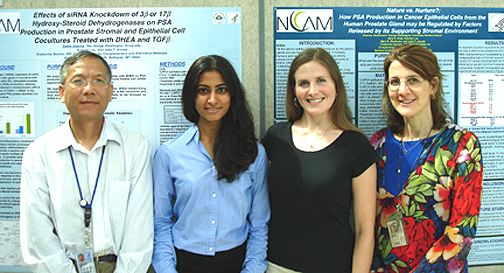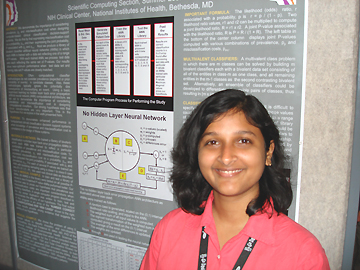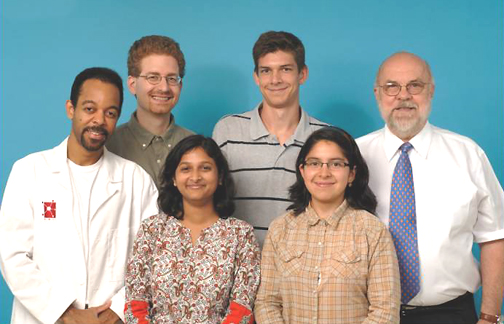SUMMER POSTER DAY: DISPLAYING THE REWARDS OF STUDENT-MENTOR TEAMWORK
Summer Research Poster day, held this year August 1, showcased 725 posters. Following is some of the work from two labs, the NCCAM Laboratory of Clinical Investigation and the CC Scientific Computing Section.
Plumbing Prostate Cancer Cells "Effects of siRNA Knockdown of 3b or 17b Hydroxy-Steroid Dehydrogenases on PSA Production in Prostate Stromal and Epithelial Cell Cocultures Treated with DHEA and TGFb," Sweta Sharma, The George Washington University, Washington, D.C., Xunxian Liu, and Julia Arnold, Laboratory of Clinical Investigation, Endocrine Section, NCCAM. "Nature vs. Nurture?: How PSA Production in Cancer Epithelial Cells from the Human Prostate Gland may be Regulated by Factors Released by Its Supporting Stromal Environment," Patricia Reutemann, GWU Medical School, Nora E. Gray, Xunxian Liu, Marc R. Blackman, and Julia T. Arnold, Endocrine Section, NCCAM Patty Reutemann and Sweta Sharma of George Washington University (GWU) explored possible mechanisms of how prostate stromal cells can affect prostate epithelial cancer cells, particularly in the presence of dehydroepiandrosterone (DHEA). DHEA is an endogenous hormone made by the adrenal gland in high concentrations, although levels decrease with age. DHEA is thus used commonly as a dietary supplement for purported anti-aging benefits. In the prostate, DHEA can transform into androgens or estrogens, and this transformation may affect prostate pathophysiology. NCCAM’s Laboratory of Clinical Investigation has tested the effects of DHEA on various human prostate cell models and has found unique mechanisms of DHEA when two different cell types are cultured together. DHEA’s effect on prostate cancer cells is minimal when they are grown alone, but when the prostate stromal cells—the cells from associated prostate connective tissue—are included, DHEA’s effects are accentuated. The addition of TGFb-1 induces reactive prostate stroma, similar to stroma associated with inflammation in the cancer tissue microenvironment. Earlier NCCAM research found increased metabolism of DHEA towards androgens when TGFb-1 is added, as measured by increased prostate-specific antigen (PSA) production in the cancer cells. Reutemann, who is entering her second year at GWU medical school with a concentration in integrative medicine, used a real-time PCR array targeting 84 human growth factor genes to search for potential secondary paracrine factors expressed by the stromal cells that may contribute to the androgenic effect on the epithelial cells. Included in her results were andromedins, such as IGF-1, FGF-1, and FGF-7. Sharma, a GWU undergraduate studying biology and computer science, targeted the stromal metabolism of DHEA to androgens or estrogens by using a silencing RNA approach for the enzymes involved in steroid metabolism. She showed that silencing either 17b hydroxysteroid dehydrogenase type 1 or type 5 in the stromal cells reduced the epithelial cell PSA production in these co-cultures. These enzymes promote the conversion of DHEA into testosterone, which may in turn fuel the prostate cancer’s growth. Reutemann said her CAM-infused research at medical school "is the best of both worlds," providing disciplined research training in the field of botanical and traditional medicines, a field she has long admired. The internship meshed well with her university’s requirements. Sharma is unsure about her academic path, but she noted that the internship introduced her to the trouble-shooting, frustration, and, ultimately, joy that is bench work.
Computation in Clinical Research "The Importance of Prevalence and Misclassification Cost Considerations in Computerized Clinical Decision Support Systems," Ina Sen, Arizona State University, Tempe, James DeLeo, Scientific Computing Section, Department of Clinical Research Informatics, CC Ina Sen worked at the Clinical Center this summer developing a suite of software applications to help clinical researchers better visualize and analyze patient data. She worked with three other summer interns under the direction of James DeLeo, chief of the Scientific Computing Section in the CC’s Department of Clinical Research Informatics. Her team’s projectwhich came through DeLeo as a request from Fred Miller, a senior investigator with NIEHS at the CC—was to develop a computer system to merge disparate yet related datasets and to display graphically the combined information, such as analyte values from numerous patients. The goal is to provide a desktop tool that enables researchers to create snapshots of data as parallel coordinates or star glyphs, to chart changes over time, mine data, perform statistical analyses, and potentially reveal unrealized connections among data. Sen is a graduate of the Indian Institute of Technology Roorkee, Uttaranchal, and is now a third-year doctoral candidate at Arizona State University studying computer science with a concentration in bioinformatics and machine learning. One of her tasks on the team was to participate in the design of computational classifiers for both supervised and unsupervised computer learning. Supervised learning would entail using factors such as analyte values associated with confirmed diagnosed cases to teach the computer to classify new cases as normal or diseased. In unsupervised learning, cases are unlabeled—that is, diagnostic categories are either unknown or assumed to be unknown, and the computer uses feature values to cluster cases, resulting in confirmation of existing diagnostic categories or suggestions of new ones. Sen said that computational classifier methodologies often do not consider prevalence–that is, an expected or prior probability of events—or they ignore the potentially dire consequence of misclassifying an event in candidate classes. Thus, one focus of her work was to demonstrate the importance of considering prevalence and misclassification costs. Her analysis, based on the output of real CC data processed through an artificial neural network, indeed supported this hypothesis, and Sen recommends that consideration of these two factors be incorporated in computational classifiers. DeLeo and his colleague Carl Leonard in the Scientific Computing Section will continue this software development with Miller and look for opportunities to leverage the experience gained on this project to support other clinical investigators in a similar manner.
|


